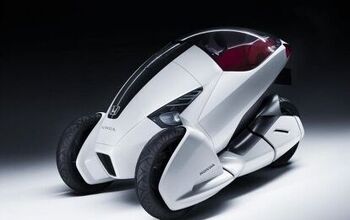BMW's Turbo Goes Back to the Future
BMW recently surprised enthusiasts by announcing that they're adding a turbo-charged 3-Series to their line-up. For a company famous for its sweet-spinning, normally aspirated six-cylinder engines, a turbo-3 seems a quirky development– to say the least. Twenty years ago, sure. Back then, [gasoline powered] turbocharged cars were THE answer, promising all the power of a big engine with the fuel economy of a small engine. Of course, it wasn't true then, and it's not true now.
In theory, a turbocharger captures some of the wasted energy in a car's exhaust system to "enhance" the engine's performance. In practice, a turbocharger is nothing more than a fan placed in the exhaust stream that powers a supercharger. The supercharger force-feeds fuel-rich air into the engine's combustion chamber. The resulting engine acts as if it has more displacement than the physical measurements of its bore and stroke indicate.
In the '80s, consumers demanded more powerful cars– at a time when automakers had spent fortunes downsizing their cars and scaling back their engines. A turbo was seen as a quick way to add power to existing powerplants. Car companies started bolting turbos onto their small engines as fast as Garrett and other suppliers could make them.
By the mid-80s, Chrysler offered four-cylinder turbo engines in all of their products, including minivans. Buick turbocharged the antediluvian V6 and made a performance car out of a family sedan. Pontiac added a turbo to the anemic Olds V8 they inherited for the Firebird. Ford even offered two turbo Lincolns, a four-cylinder gasoline engine and a six-cylinder diesel.
The drawbacks soon became apparent. Top of the list: "turbo lag". Because it takes time for the engine's exhaust gases to spool-up the turbo's fan, acceleration lagged behind engine demand. This problem was exacerbated by the rather primitive engine controls available at the time. The lower compression ratios, required by any supercharged engine back then, also reduced response and performance. The result was soggy response, poor part throttle economy, and non-linear acceleration at constant throttle openings.
The turbo also made a number of very un-car-like noises, especially to people whose ears had matured to the music of a V8. Some of those noises turned expensive; neglecting routine maintenance often resulted in a short life for the turbo. Skimping on oil changes and oil quality led to premature bearing failures and required replacement of the turbo.
Drivers soon noticed that turbo-induced power wasn't really "free". The basic laws of physics mandate that fuel mileage depends on how much the car weighs and how fast you go. When a small engine makes power like a large engine, it uses gas like a large engine as well. Eventually the carmakers developed larger engines that weighed the same or less than the older four-cylinder engines equipped with a turbo. These larger engines provided better performance without all of the quirks of the turbo.
A number of manufacturers turned to superchargers. A supercharger pressurizes the intake air, just like a turbo, but is mechanically driven by the engine. A modern supercharger can run at a much slower speeds and deliver an equivalent amount of air to the engine as a turbo. Since superchargers are engine-driven and constantly engaged, there's no lag between driver demand and engine response. Buick ditched the turbo and supercharged their venerable V6. Ford, faced with disappointing power outputs from their modular engines, likewise added superchargers to some of their cars. Mercedes currently relies on superchargers for many of their high performance models.
In today's rallying scene, where engine displacement is limited by regulation, teams still turn to turbos for extra performance and live with the attendant idiosyncrasies. That's why Subaru and Mitsubishi install turbos on their fearsome rally cars. Buyers of the street versions tolerate the usual drawbacks in exchange for blistering acceleration at the top of the rev range, and the panache of driving a copy of a WRC rally car.
Mercedes currently produces several road cars using twin turbos– a smaller turbo to get the supercharger up to speed under light throttle, and a larger one to add power once the waste gasses are flowing freely. This set-up virtually eliminates turbo lag and maximizes engine power, but its complexity, inefficiency and expense restrict the system to the company's top-of-range models. [MB's lesser-priced performance cars rely on large displacement engines or superchargers.] The same parameters apply to the top-of-the-range Porsche Turbo, and will most likely relate to the new turbocharged six-cylinder BMW.
Further down the food chain, the turbo-charged engine is a dead duck. Low cost, fuel-efficient turbo solutions are both unavailable and commercially undesirable. The turbocharged minivan is gone forever. Besides, when it comes to smooth power, reliability and aural satisfaction, wouldn't you really rather have a V8?
More by Bob Elton
Latest Car Reviews
Read moreLatest Product Reviews
Read moreRecent Comments
- SCE to AUX Figure 160 miles EPA if it came here, minus the usual deductions.It would be a dud in the US market.
- Analoggrotto EV9 sales are rivalling the Grand Highlander's and this is a super high eATP vehicle with awesome MSRPs. Toyota will need to do more than compete with a brand who has major equity and support from the automotive journalism community. The 3 row game belongs to HMC with the Telluride commanding major marketshare leaps this year even in it's 5th hallowed year of ultra competitive sales.
- Analoggrotto Probably drives better than Cprescott
- Doug brockman I havent tried the Honda but my 2023 RAV4 is great. I had a model 20 years ago which. Was way too little
- Master Baiter The picture is of a hydrogen fuel cell vehicle.


































Comments
Join the conversation